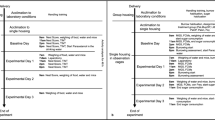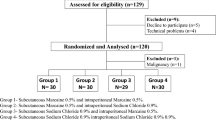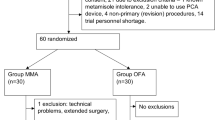Abstract
In this study, the authors evaluated the analgesic efficacy of tramadol (an opioid-like analgesic), carprofen (a nonsteroidal anti-inflammatory drug) and a combination of both drugs (multimodal therapy) in a rat laparotomy model. The authors randomly assigned rats to undergo either surgery (abdominal laparotomy with visceral manipulation and anesthesia) or anesthesia only. Rats in each group were treated with tramadol (12.5 mg per kg body weight), carprofen (5 mg per kg body weight), a combination of tramadol and carprofen (12.5 mg per kg body weight and 5 mg per kg body weight, respectively) or saline (anesthesia control group only; 5 mg per kg body weight). The authors administered analgesia 10 min before anesthesia, 4 h after surgery or (for the rats that received anesthesia only) anesthesia and 24 h after surgery or anesthesia. They measured locomotor activity, running wheel activity, feed and water consumption, body weight and fecal corticosterone concentration of each animal before and after surgery. Clinical observations were made after surgery or anesthesia to evaluate signs of pain and distress. The authors found that carprofen, tramadol and a combination of carprofen and tramadol were all acceptable analgesia regimens for a rat laparotomy model.
This is a preview of subscription content, access via your institution
Access options
Subscribe to this journal
We are sorry, but there is no personal subscription option available for your country.
Buy this article
- Purchase on Springer Link
- Instant access to full article PDF
Prices may be subject to local taxes which are calculated during checkout




Similar content being viewed by others

References
Code of Federal Regulations, Title 9 Chapter 1, Subchapter A – Animal Welfare: Part 2 Regulations (§2.31).
Institute for Laboratory Animal Research. Guide for the Care and Use of Laboratory Animals (National Academy Press, Washington, DC, 1996).
Lascelles, B.D., Butterworth, S.J. & Waterman, A.E. Postoperative analgesic and sedative effects of carprofen and pethidine in dogs. Vet. Rec, 134, 187–191 (1994).
Liles, J.H. & Flecknell, P.A. A comparison of the effects of buprenorphine, carprofen and flunixin following laparotomy in rats. J. Vet. Pharmacol. Ther. 17, 284–290 (1994).
Flecknell, P.A., Orr, H.E., Roughan, J.V. & Stewart, R. Comparison of the effects of oral or subcutaneous carprofen or ketoprofen in rats undergoing laparotomy. Vet. Rec. 144, 65–67 (1999).
Roughan, J.V. & Flecknell, P.A. Behaviour-based assessment of the duration of laparotomy-induced abdominal pain and the analgesic effects of carprofen and buprenorphine in rats. Behav. Pharmacol. 15, 461–472 (2004).
Papich, M.G. Pharmacological considerations for opiate analgesic and nonsteroidal anti-inflammatory drugs. Vet. Clin. North Am. Small Anim. Pract. 30, 815–837 viii (2000).
Guneli, E., Karabay Yavasoglu, N.U., Apaydin, S., Uyar, M. & Uyar, M. Analysis of the antinociceptive effect of systemic administration of tramadol and dexmedetomidine combination on rat models of acute and neuropathic pain. Pharmacol. Biochem. Behav. 88, 9–17 (2007).
Clark, J.A. Jr., Myers, P.H., Goelz, M.F., Thigpen, J.E. & Forsythe, D.B. Pica behavior associated with buprenorphine administration in the rat. Lab. Anim. Sci. 47, 300–303 (1997).
Raffa, R.B. et al. Opioid and nonopioid components independently contribute to the mechanism of action of tramadol, an atypical opioid analgesic. J. Pharmacol. Exp. Ther. 260, 275–285 (1992).
Papich, M. Tramadol. Saunders Handbook of Veterinary Drugs 2nd edn. (Saunders Elsevier, St. Louis, 2007).
Raffa, R. The basic science aspect of tramadol hydrochloride. Pain Rev. 3, 249–271 (1996).
Slingsby, L.S. & Waterman-Pearson, A.E. Analgesic effects in dogs of carprofen and pethidine together compared with the effects of either drug alone. Vet. Rec. 148, 441–444 (2001).
Cloutier, S. & Newberry, R. Tickled pink: Playful handling as social enrichment for laboratory rats. AWI Quarterly 58, 24–25 (2009).
Roughan, J.V. & Flecknell, P.A. Evaluation of a short duration behaviour-based post-operative pain scoring system in rats. Eur. J. Pain 7, 397–406 (2003).
Neter, J., Kutner, M., Nachtsheim, C. & Wasserman, W. Applied Linear Statistical Models 4th edn. (WCB McGraw-Hill, Boston, 1996).
Conover, W.J. Practical Nonparametric Statistics (I. John Wiley and Sons, New York, 1971).
Marler, M.R., Gehrman, P., Martin, J.L. & Ancoli-Israel, S. The sigmoidally transformed cosine curve: a methematical model for circadian rhythms with symmetric non-sinusoidal shapes. Stat. Med. 25, 3893–3904 (2006).
Flecknell, P.A. & Liles, J.H. Evaluation of locomotor activity and food and water consumption as a method of assessing post-operative pain in rodents. Animal Pain (eds. Short, C. & Van Poznak, A.) 482–488 (Churchill Livingstone, New York, 1991).
Flecknell, P.A. & Liles, J.H. The effects of surgical procedures, halothane anaesthesia and nalbuphine on locomotor activity and food and water consumption in rats. Lab. Anim. 25, 50–60 (1991).
Krugner-Higby, L. et al. Liposome-encapsulated oxymorphone hydrochloride provides prolonged relief of postsurgical visceral pain in rats. Comp. Med. 53, 270–209 (2003).
Clark, M.D. et al. Evaluation of liposome-encapsulated oxymorphone hydrochloride in mice after splenectomy. Comp. Med. 54, 558–563 (2004).
Stewart, L.S.A. & Martin, W.J. Evaluation of postoperative analgesia in a rat model of incisional pain. Contemp. Top. Lab. Anim. Sci. 42, 28–34 (2003).
Cannon, C.Z., Kissling, G.E., Hoenerhoff, M.J., King-Herbert, A.P. & Blankenship-Paris, T. Evaluation of dosages and routes of administration of tramadol analgesia in rats using hot-plate and tail-flick tests. Lab Anim. (NY) 39, 342–351 (2010).
Gould, T., Dao, D. & Kovacsics, C. The open field test. Neuromethods 42, 1–20 (2009).
Loram, L.C., Mitchell, D., Skosana, M. & Fick, L.G. Tramadol is more effective than morphine and amitriptyline against ischaemic pain but not thermal pain in rats. Pharmacol. Res. 56, 80–85 (2007).
Wu, W.N., McKown, L.A., Codd, E.E. & Raffa, R.B. Eur. J. Drug Metab. Pharmacokin. 27, 193–197 (2002).
Liles, J.H. & Flecknell, P.A. The effects of surgical stimulus on the rat and the influence of analgesic treatment. Br. Vet. J. 149, 515–525 (1993).
Archer, J. Tests for emotionality in rats and mice: a review. Anim. Behav. 21, 205–235 (1973).
Nolan, A. & Reid, J. Comparison of the postoperative analgesic and sedative effects of carprofen and papaveretum in the dog. Vet. Rec. 133, 240–242 (1993).
Mathews, K.A. Nonsteroidal anti-inflammatory analgesics in pain management in dogs and cats. Can. Vet. J. 37, 539–545 (1996).
Lascelles, B.D., Cripps, P.J., Jones, A. & Waterman-Pearson, A.E. Efficacy and kinetics of carprofen, administered preoperatively or postoperatively, for the prevention of pain in dogs undergoing ovariohysterectomy. Vet. Surg. 27, 568–582 (1998).
McKellar, Q.A., May, S.A. & Lees, P. Pharmacology and therapeutics of nonsteroidal antiinflammatory drugs in the dog and cat. 1. General pharmacology. J. Small Anim. Pract. 32, 225–235 (1991).
Reimer, M.E. et al. The gastroduodenal effects of buffered aspirin, carprofen, and etodolac in healthy dogs. J. Vet. Intern. Med. 13, 472–427 (1999).
McQuay, H.J., Carroll, D., Watts, P.G., Juniper, R.P. & Moore, R.A. Codeine 20 mg increases pain relief from ibuprofen 400 mg after third molar surgery. A repeat-dosing comparison of ibuprofen and an ibuprofen-codeine combination. Pain 37, 7–13 (1989).
Jonsson, T., Rude, C. & Banberg, F.A. Postoperative pain treated with piroxicam and buprenorphine, each drug alone or in a combination. Pain 41, S144 (1991).
Wideman, G.L. et al. Analgesic efficacy of a combination of hydrocodone with ibuprofen in postoperative pain. Clin. Pharmacol. Ther. 65, 66–76 (1999).
Picard, P., Bazin, J., Conio, N., Ruiz, F. & Schoeffler, P. Ketorolac potentiates morphine in postoperative patient-controlled analgesia. Pain 73, 401–406 (1997).
Acknowledgements
We thank Danielle Waxer, James Clark, Page Myers, Sandy Hackney, Joe Hensley and Rodney Chavis for their assistance and support of the research and care of the animals. We thank Dr. Paul Flecknell for his consultation; Dr. Larry Wright for his assistance in literature evaluation; The Brookfield Zoo Endocrinology Lab for carrying out the corticosterone assay; Dr. Mark Cesta for pathology; Eli Ney for imaging; and Dr. Mary Grant, Dr. Mark Hoenerhoff and Dr. Gregory Cannon for manuscript review. This research was supported by the Intramural Research Program of the National Institutes of Health and the National Institute of Environmental Health Sciences. This article may be the work product of an employee or group of employees of the National Institute of Environmental Health Sciences (NIEHS), National Institutes of Health (NIH), however, the statements, opinions or conclusions contained herein do not necessarily represent the statements, opinions or conclusions of NIEHS, NIH or the United States government.
Author information
Authors and Affiliations
Corresponding author
Ethics declarations
Competing interests
The authors declare no competing financial interests.
Rights and permissions
About this article
Cite this article
Cannon, C., Kissling, G., Goulding, D. et al. Analgesic effects of tramadol, carprofen or multimodal analgesia in rats undergoing ventral laparotomy. Lab Anim 40, 85–93 (2011). https://doi.org/10.1038/laban0311-85
Received:
Accepted:
Published:
Issue Date:
DOI: https://doi.org/10.1038/laban0311-85
This article is cited by
-
Renal denervation ameliorates cardiac metabolic remodeling in diabetic cardiomyopathy rats by suppressing renal SGLT2 expression
Laboratory Investigation (2022)
-
Effect of variations in dietary Pi intake on intestinal Pi transporters (NaPi-IIb, PiT-1, and PiT-2) and phosphate-regulating factors (PTH, FGF-23, and MEPE)
Pflügers Archiv - European Journal of Physiology (2018)
-
Side effects of pain and analgesia in animal experimentation
Lab Animal (2017)
-
Mixed-strain housing for female C57BL/6, DBA/2, and BALB/c mice: validating a split-plot design that promotes refinement and reduction
BMC Medical Research Methodology (2016)
-
Evaluation of buprenorphine hydrochloride Pluronic® gel formulation in male C57BL/6NCrl mice
Lab Animal (2016)


